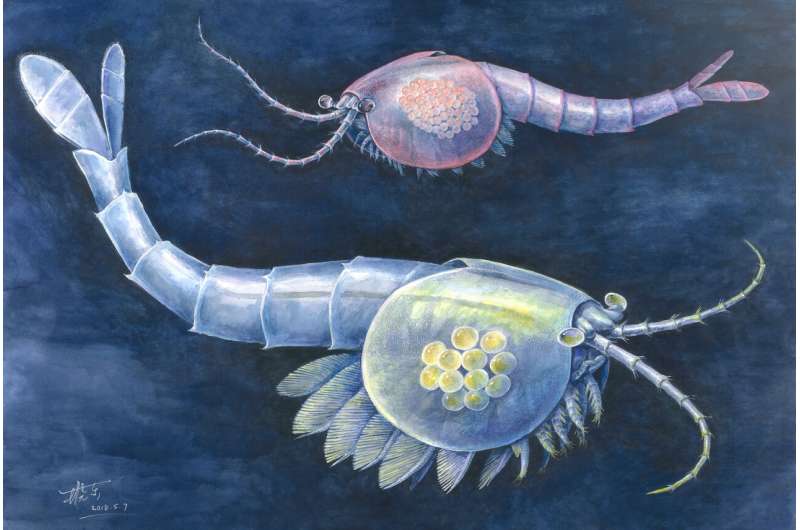April 30, 2020 report
Example found of evolutionary tradeoff in ancient shrimp-like species

A team of researchers with members affiliated with institutions in China, Germany and France has found an example of evolutionary tradeoff in Cambrian arthropods. In their paper published in the journal Science Advances, the group describes how they compared egg and cluster sizes in a closely related species of ancient shrimp and what they learned from it.
Prior research has shown that the evolutionary history of most living organisms is filled with tradeoffs. Developing colored feathers is one example: doing so helps attract a mate, but colorful birds tend to be more easily spotted by predators. Another example is the number of offspring a species may produce. Having many makes the likelihood of some of them surviving more likely, but large broods lead to less protection from parents.
In this new effort, the researchers compared the tradeoffs faced by Chaundianella ovata and Waptia fieldensis—two closely related Cambrian arthropods. The researchers studied fossilized specimens found in parts of China and Canada. The fossilized remains of Chaundianella ovata showed them producing large numbers of eggs (100 on average). Waptia fieldensis, on the other hand, tended to produce fewer numbers of eggs (25 on average), but those that were produced were larger, with much larger yolks. Both species lived approximately 500 million years ago. The smaller eggs produced by Chaundianella ovata were approximately 0.5 mm, and were held in the female's body under the lateral carapace flaps, which helped to protect them against predators and disease. Because they had small yolks, they offered less to eat to developing embryos, which made the offspring less likely to survive. In sharp contrast, the larger eggs produced by Waptia fieldensis were approximately 2 mm and had much larger yolks, providing the offspring a larger meal, and helping their chances of survival. These reproductive differences between two very closely related species suggests they engaged in an evolutionary tradeoff between quantity and quality of offspring. Large clutches helped ensure that at least some offspring would survive due to their sheer numbers. But smaller clutches allowed the parents to protect the offspring better. The researchers suggest that the reproductive tradeoffs by the Cambrian shrimp relatives could have facilitated evolutionary success for the early arthropods.
More information: Qiang Ou et al. Evolutionary trade-off in reproduction of Cambrian arthropods, Science Advances (2020). DOI: 10.1126/sciadv.aaz3376
Journal information: Science Advances
© 2020 Science X Network


















